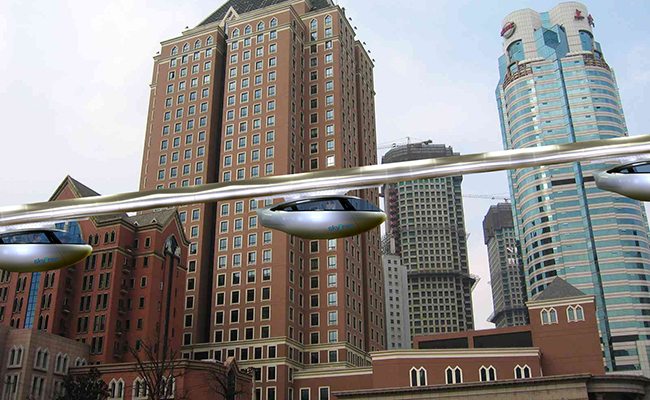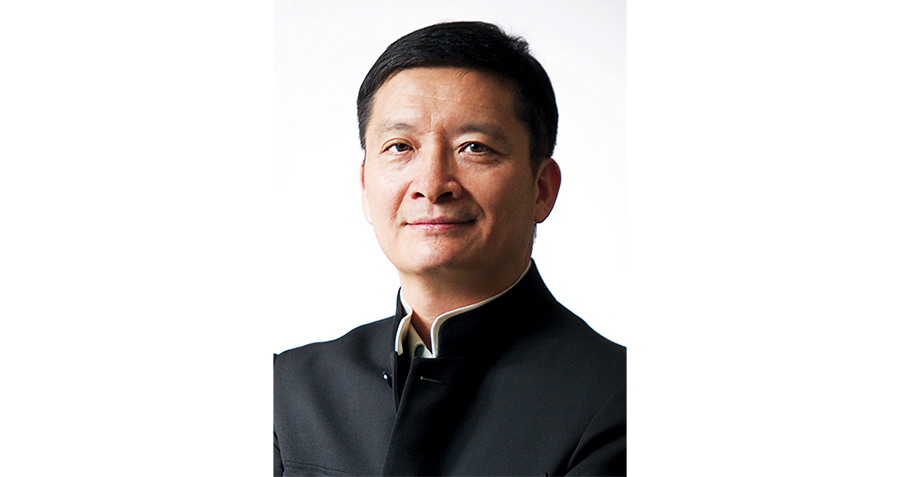
SkyTran CEO Jerry Sanders is betting big on an elevated personal rapid transportation system, with NASA’s backing.
The road traffic situation is getting worse around the world and China is no exception. Not only are first-tier cities like Beijing and Shanghai being overwhelmed by traffic problems, even small cities and towns are starting to see jams on the road.
Jerry Sanders, CEO of SkyTran, a NASA Space Act company, says that to relieve traffic, we have to go above the road. His company provides a possible solution: SkyTran, a personal rapid transportation (PRT) system with small, computer-controlled maglev capsules running on elevated rails. With its fast speed, it claims to have the ability to solve the problem of congestion in cities.
The company, located in NASA Ames Research Park near Mountain View, California, is building its first demonstration working system, which is near completion, in Tel Aviv and a commercial system in Abu Dhabi.
Is elevated transit a practical solution? How will it fit into our cities and relieve jams? Is it the future of transportation? Sanders spoke with CKGSB Knowledge during his recent trip to Beijing. Excerpts from the interview.

Q. When people talk about innovative ways of transportation, they think of many different things like self-driving cars, the Maglev and the high-speed rail. How did SkyTran first come up with the idea of its current PRT system?
A. SkyTran was first developed by a fellow who worked on the NASA Apollo program to take a man to the moon. He is a very creative scientist and engineer and he realized that for transportation to be effective, it had to go above traffic. It’s no longer sustainable to add cars to the road. When he realized that, he also realized that any system has to be fast enough to be able to connect the city center with the suburbs, because the cities have become megacities.
It was that insight let him to develop a unique type of maglev system, very different than any other maglev. Over the years, the team has come together and developed it further and filed more and more patents. So that today we have a unique maglev system that costs about one to two or three percent of what the traditional maglev cost is, both in build, maintain and operate.
Q. What’s the difference between SkyTran and the Hyperloop 1 and ET3 (both are companies developing high-speed transportation in tubes)?
A. The difference between SkyTran and Hyperloop 1 and ET3 is that those systems, if they work, take a very large footprint. They’re very big systems and require a lot of space. SkyTran, in contrast, only requires an 18-inch steel pole, because it rests on a steel bowl and the SkyTran vehicles are small enough to go inside buildings, from the top of buildings, over yards…. Neither Hyperloop 1 nor ET3 or any other companies like that are able to provide service inside the city.
They’re also going to be very expensive not only to build, but also to operate and maintain because they rely not only on, in some cases, maglev, in some cases, some other form of movement, but also on vacuum tubes, so they have to maintain these vacuum tubes, making sure there are no leaks, over hundreds of kilometers. So I think they have a big challenge.
We have a big challenge too. Our challenge is not technological though; our challenge is to get the government leaders and business leaders to recognize there has to be a solution to urban transportation.
Q. SkyTran is targeting personal transportation rather than pubic transport; how can it help relieve the pressure on traffic?
A. We’re a public transportation system. The difference is we provide personalized service. So when you get on a SkyTran vehicle, it will feel like your own private car. But in fact it’s open to the entire public. The benefit of having a personalized system means that follows your schedule.
What we find today in public transportation is that people believe incorrectly that public transportation has to carry 100 people in one carriage or one vehicle. That’s simply not correct. The task of a public transportation system is not how many people can fit into a vehicle, but rather how many people can that system overall move in a given period of time for a given amount of money.
Q. You mentioned before the charge will only be slightly more than bus fees. Can you explain what the company’s business model is like?
A. SkyTran costs one-tenth of the light rail. [SkyTran’s] operating costs are very low because it’s all software operated, and maintenance costs are low because the system knows who is using the system so we expect vandalism will be very low.
SkyTran is a premium service and we think it should priced somewhere in between public [transport] and the taxi cab. Maybe it should be even higher than the taxi cab because it doesn’t stay in traffic. But that’s a question that has to be decided by the regulators and by the people who decide how they wish to [use] SkyTran in their city.
With regard to the business model, in some cases if the government wants to buy SkyTran and run it on its own and charge whatever it wishes to charge, we simply sell the government or the regional authority the SkyTran system, then they can charge however much they want.
In other places we are proceeding on a build own operate model where the government gives us the approval and the right and we build the system. We finance it ourselves and we collect the revenue ourselves. So there are different business models.
Q. We know that SkyTran is building its first commercial systems in Tel Aviv and Abu Dhabi. Why did you pick these two places to build it?
A. We chose Abu Dhabi because our agreement is directly with the government in Abu Dhabi, and that allows us to move very quickly without any legal or regulatory or bureaucratic hurdles because we’re working for the government. In Israel we have the support of government, so although we don’t work with the government, we’re getting support from various ministries and we have growing demand already from three Israeli cities asking for transportation systems.
Those two places are representing the kind of markets where there is not a great regulatory or bureaucratic hurdle to enter the market. In the US, in contrast, we find a very difficult environment for business today, lots of regulations, lots of legal challenges, lots of layers of bureaucracy, so it’s very difficult to build new infrastructure projects in the US.
Q.Except for getting government support, what other challenges is SkyTran facing?
A. I think some industries require what we call a “safe harbor” during their development phase. That means that new technologies, new industries need government protection from lawsuits, from regulation, from bureaucracy in order to become mature.
Once they’re mature, they can defend themselves, but until they mature, they can be killed very easily.
Q. If the Chinese government seeks innovative ways of transportation and they reach to SkyTran, which city will you pick?
A. I think for a demonstration system, the best place to build a new SkyTran system is a new city, or a smaller city, not in the center of urban areas in China, to show the government and to show the population that it works and how it works. And then we can start moving to bigger and bigger cities. But initially, I think the best way forward is to build a demonstration system somewhere in China and actually we’re talking with a number of places in China to do that.
We’re talking to various regional governments right now. I cannot go to details now but I hope to be able to do so soon.
Q. How will new technologies reshape the future of public transportation and personal transportation? To your mind, how will city transportation evolve?
A. We know one thing , that is that vehicle kilometer travel, or VKT, rises in direct proportion to the available lane of kilometer roadway, or ALKR. That means the more roads you build, the more traffic you get. And the more space you have on the road, the more traffic you get. So we know that surface traffic is unsustainable worldwide.
There are more cars coming on the road, and there are roads being built, and so we cannot be like an ostrich with our head in the sand and pretend that’s not happening. The only way we’re going to get a different lifestyle is to provide alternatives to surface traffic, otherwise we’re going to have miserable lives.
And so what we’re going to see is not the advent of shared cars, computerized cars or electric cars, because all of those will be on the surface traffic. What we are going to see I believe is the advent of other modes that avoid the surface, elevated transportation, some form of vehicle can lift up directly, travel in land directly, like a helicopter.
Q. Do you think innovative new transportation technologies will replace traditional ones?
A. I don’t think they will ever replace traditional ones. I think there is always room for surface mobility. The surface mobility may look different, may be electric, may be computerized, may be with unique roadways that have a form of conveyer belt built into them…all these technologies are being developed, but I think you will see additional modes of transportation to elevate, so we’ll have a multi-mode transportation system.
















